Seljuk architecture
| Part of a series on the |
| Culture of Turkey |
|---|
 |
| History |
| People |
| Languages |
| Cuisine |
| Festivals |
| Religion |
| Art |
| Literature |
|
Music and performing arts |
| Sport |
|
Monuments |
|
Symbols |
|
Seljuk architecture is the name given to architecture built during the time when the Seljuks ruled most of the Middle East and Anatolia between (11th - 13th Centuries). After the 11th century the Seljuks of Rum emerged from the Great Seljuk Empire developing their own architecture, though they were influenced and inspired by the Armenians, Byzantines and Persians.
Great Seljuq Empire architecture
The architecture can be found in a vast area stretching from the Hindu Kush to eastern Anatolia and from Central Asia to the Persian Gulf. The homeland of the Seljuk architecture was Turkmenistan and Iran, where the first permanent Seljuk buildings were built. Unfortunately the Mongol invasions and earthquakes destroyed most of these buildings and only a few remain. In 1063 Isfahan was established as capital of the Great Seljuk Empire under Alp Arslan.
The most significant alteration carried out in the early twelfth century was the conversion of the mosque plan into a four-iwan plan mosque. Another mosque-type introduced at this time was the kiosk mosque, consisting of a domed space with three open sides and wall containing a mihrab on the qibla side.The architecture of this period was also characterized by memorial tombs which were usually octagonal structures with domed roofs, called Kümbet or Türbe. An impressive example of tomb architecture is the mausoleum of Sultan Sanjar at Merv, a massive building measuring 27 metres (89 feet) square with a huge double dome resting on squinches and muqarnas pendentives.
In Syria and Iraq the surviving monuments are represented by madrassas and tombs. The madrassas such as the Mustansiriya in Baghdad or the Muristan in Damascus were built to a four-iwan plan, while the tombs were characterized by conical muqarnas domes.
Some examples of Seljuk Empire architecture include:
Anatolian Seljuk architecture
The greatest number of surviving Seljuk monuments are in Anatolia. The Seljuks of Rum built monumental stone buildings of elegantly simple design and harmonious proportion, for the most part severely plain, but with bursts of elaborate decoration around doorways.
In their construction of caravanserais, medreses and mosques, the Rum Seljuks translated the Iranian Seljuk architecture of bricks and plaster into the use of stone.[1] Among these, the caravanserais (or hans), used as stops, trading posts and defense for caravans, and of which about a hundred structures were built during the Anatolian Seljuqs period, are particularly remarkable. Along with Persian influences, which had an indisputable effect,[2] Seljuk architecture was also influenced by Armenian architecture, such as by having Muslim architects who originated from historical Armenia, and by having Armenian architects and masons.[3][4] As such, Anatolian architecture represents some of the most distinctive and impressive constructions in the entire history of Islamic architecture. Later this Anatolian architecture would be transmitted to Sultanate India.[5]
Most Anatolian Seljuk works are of dressed stone, with brick reserved for minarets. The use of stone in Anatolia is the biggest difference with the Seljuk buildings in Iran, which are made of bricks. The buildings make frequent use of muqarnas (stalactite vaulting). In the Seljuk Sultanate of Rum the courts are often covered to protect against the colder and snowier winters of the Anatolian plateau. Thus some madrasas (theological seminaries) such as the Çifte Minareli Medrese in Erzurum have an open court, and others, such as the Karatay Medrese in Konya, have covered courts.
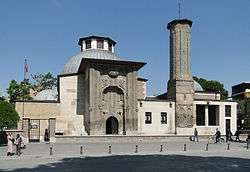
.
Konya, the capital of the Seljuks and the other great Seljuk cities--Alanya, Erzurum, Kayseri, Sivas—have important Seljuk buildings, but Seljuk works are abundant in almost any Anatolian city or town, especially in Central and Eastern Anatolia. Seljuk power extended (briefly) as far as the Aegean coast, so there are Seljuk türbes (tombs) even in—appropriately—the town of Selçuk, next to Ephesus, south of İzmir. The great caravanserais, or hans, are among the finest and most characteristic of Seljuk buildings. Built during the 13th century to encourage trade throughout the empire, several dozen survive in good condition.
After the Mongol invasions of the mid-13th century, the wealth and power of the Seljuk empire declined. The few late 13th century-early 14th century buildings that survive include the bimarhane (madhouse) in Amasya, and the "Süngür Bey Mosque" in Nigde.
Examples of Anatolian Seljuk architecture
| Style | Modern Turkish nomenclature | Example |
|---|---|---|
| Mosque | Cami | Alâeddin Mosque |
| Madrasa | Medrese | Çifte Minareli Medrese |
| Kümbet | Kümbet | Döner Kümbet |
| Caravanserai | Kervansaray | Sultan Han |
| Hospital | Darüşşifa | Divriği Great Mosque |
| Bridge | Köprü | Akköprü |
| Palace | Saray | Kubadabad Palace |
| Castle | Kale | Alanya Castle |
| Shipyard | Tersane | Kızıl Kule |
See also
| Wikimedia Commons has media related to Seljuq architecture. |
- Havadan Külliye
- Seljuq dynasty
- Great Seljuq Empire
- Sultanate of Rûm
- List of Seljuk hans and kervansarays in Turkey
Gallery
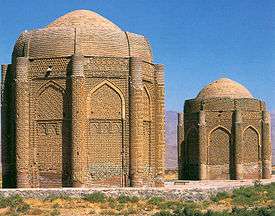 The Kharāghān twin towers, in Iran, is the burial of Seljuq princes
The Kharāghān twin towers, in Iran, is the burial of Seljuq princes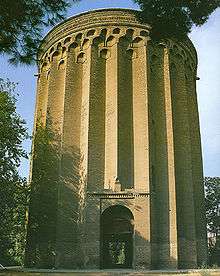
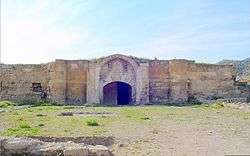


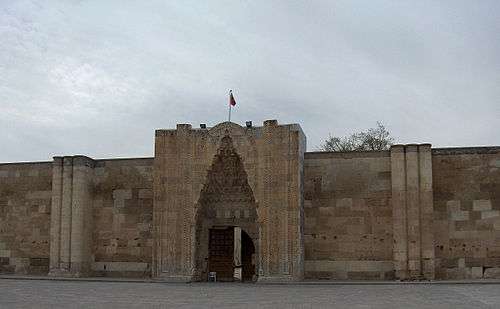 Monumental entrance of the Sultanhanı, a caravanserai built in 1229 in Aksaray, Turkey during the reign of Kayqubad I
Monumental entrance of the Sultanhanı, a caravanserai built in 1229 in Aksaray, Turkey during the reign of Kayqubad I.jpg)
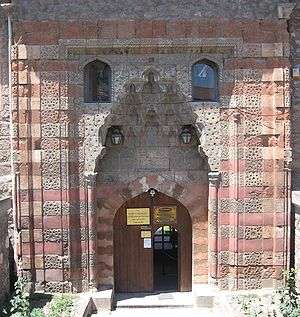

 The highly ornamented stone façade of the entrance, Ince Minaret Medrese, Konya.
The highly ornamented stone façade of the entrance, Ince Minaret Medrese, Konya.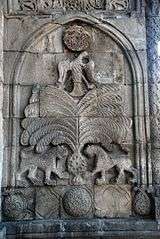 Stone carving detail of the Yakutiye Medrese.
Stone carving detail of the Yakutiye Medrese. Kümbet of Hudavend Hatun.
Kümbet of Hudavend Hatun.- Süleymaniye Mosque. Alanya.
Notes
- ↑ West Asia:1000-1500, Sheila Blair and Jonathan Bloom, Atlas of World Art, ed. John Onians, (Laurence King Publishing, 2004), 130.
- ↑ Architecture(Muhammadan), H. Saladin, Encyclopaedia of Religion and Ethics, Vol.1, ed. James Hastings and John Alexander, (Charles Scribner's son, 1908), 753.
- ↑ Henri Stierlin, "Turkey From the Selcuks to the Ottomans", Taschen's World Architecture, 1998, p73-75
- ↑ Armenia during the Seljuk and Mongol Periods, Robert Bedrosian, The Armenian People From Ancient to Modern Times: The Dynastic Periods from Antiquity to the Fourteenth Century, Vol. I, ed. Richard Hovannisian, (St. Martin's Press, 1999), 250.
- ↑ Lost in Translation: Architecture, Taxonomy, and the "Eastern Turks", Finbarr Barry Flood, Muqarnas: History and Ideology: Architectural Heritage of the "Lands of Rum, ed. Gulru Necipoglu, (Brill, 2007), 96.